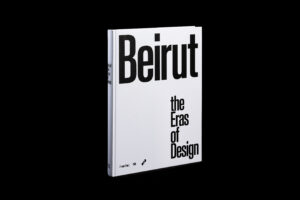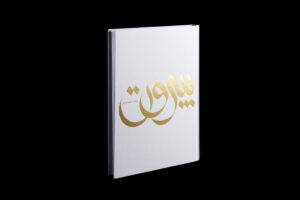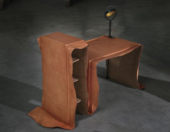



Beirut: The Eras of Design
Overview
Co-edited by Kaph Books x Mudac Lausanne.
A city at the crossroads of East and West, said to have been destroyed and rebuilt seven times since antiquity, Beirut continues to nourish the imagination of many creative artists. It was with all its paradoxes, that a design scene rapidly developed from 2000 onwards, swiftly garnering acclaim from critics, design fairs and the entire industry. The vibrance of design from Lebanon stands out as an exception in the region and needs to be understood via the country’s long-standing cultural relations with Europe, especially France, but also with the Emirates and their ancient craft traditions, which play a part in the originality of products by Lebanese designers. Beirut is building its own design culture, transforming its multiculturalism into creative energy.
This publication analyzes Lebanon’s unique situation—a convergence of economic and architectural reconstruction, social awareness and international development. It also testifies to the designers’ determination to take ownership of their destiny and image by presenting objects and forms that are simultaneously aware of their diverse heritage and are deeply rooted in a complex reality. Prior to the development of this exhibition and publication project, no extensive research has been undertaken on the history of design in Lebanon. This book aims to fill that gap, presenting the state of design based on extensive documentation. It is the first retrospective on design in Lebanon, from the 1920s until today, includes works by over 50 designers, uncovering this major design scene in the Middle-East.
About the Authors
Hala Abdel Malak
Hala ABDEL MALAK (b.1979, Lebanon) is a design critic, curator, educator, researcher and strategist. Born in Beirut during the civil war, she grew up, worked, and studied internationally, in Lebanon, USA, Canada, UAE, Holland, UK, Morocco and France before grounding in New York. Abdel Malak’s multicultural background is reflected in her versatile interconnected approach between design and business where she explores work around global dynamics, leadership and societal impact. Her interests span from re-imagining and challenging learning, knowledge production and creative education to include diverse, non-colonial and indigenous perspectives and traditional ecological knowledge, the exploration of global cultural dissonance and flow, the resonance around migration and forced displacement as well as the triggers and implications around designing for resistance, advocacy and revolt. Her work has been featured and published in Print Magazine, Design Indaba, Metropolis, AIGA, Beirut Design Week, NYC x Design, Wanted Design NYC, Smithsonian Media, MOMA and SXSW, where she was awarded the Learn by Design award for her work on refugee education. She is an Assistant Professor of Strategic Design and Management and Director of the Strategic Design and Management BBA at Parsons School of Design.
Hala Moubarak
Hala MOUBARAK (b.1982, Lebanon) is an interior designer specializing in objects design. Following her graduate degree in 2005, Moubarak worked in the Gulf countries before returning to Lebanon in 2010. Fascinated by the various processes of creation, in 2012, she became a journalist for the French-speaking Deco Magazine and uncovered many talented designers in Lebanon. From 2011 to 2017, Moubarak taught history of art and architecture, history of furniture and design; and led interior architecture and design workshops at the Holy Spirit University of Kaslik (USEK). In 2017, she co-founded the first of its kind in the country, the Beirut Design Fair, and is in charge of its artistic direction. In 2019, she created with a group of designers the first affordable collection of designed objects for Minjara Editions, funded by the European Union. Working to make design accessible, Moubarak creates projects centered on collaborations between different trades and promotes the traditional production knowledge and techniques found in Lebanon.
Cherine Magrabi Tayeb
Cherine MAGRABI TAYEB (b. Jeddah, Saudi Arabia) is the founder and curator of Lebanon's influential non-profit design platform, House of Today. Through its global reach, House of Today helped ignite the recent design boom in Beirut. Working closely with international design institutions, Tayeb held a chair on the Honorary Advisor Committee for Contemporary Muslim Fashions at the San Francisco Contemporary Museum, and is currently a member of FD100 - an international jury composed of curators and directors from major design institutions and prominent media who will select the top 100 designers and interior designers that best represent the values of French design around the world. Tayeb is also a founding patron of the Beirut Art Center and sits on numerous design competition judging panels as well as boards of museums and design institutions internationally. She is the Creative & Communication Director at Magrabi, the leading optical retail chain in the Middle East. Most recently, Tayeb unveiled 13BC, her own brand of exclusive, collectible and limited-edition minaudières.
Marc Baroud
Marc BAROUD (b.1978, Lebanon) is an inter-disciplinary designer. He practices his design method in a large array of projects. In 2012, Baroud founded the Design Department at Académie Libanaise des Beaux-Arts (ALBA) and directed it until 2017. His objective was to reform design education while using the same contextual approach as he uses in designing. The implemented curriculum envisioned design as a broader discipline rather than one limited to creating aesthetics and artifacts. Based between Paris and Beirut, Baroud works on bridging these two cities and cultures, as well as across several areas of design. His projects include commercial architecture, scenography, interior design, furniture, services and brand development. As a product designer, Baroud works on industrial, artisanal and experimental projects, consulting for private initiatives, start-ups, as well as big corporations. His collectible works have been shown in Beirut, Brussels, Dubai, London, Milan, Paris, Design/Miami and Design/Miami Basel. His work is in the permanent collections of both private and public institutions, including Musée des Arts Décoratifs in Paris and mudac in Lausanne.
Marco Costantini
Marco COSTANTINI (born 1970, Switzerland) is an art historian, exhibition curator and director of mudac, museum of Contemporary Design and Applied Arts in Lausanne, where he organized the exhibitions: Face au mur (2010), Nirvana (2015) and Miroir Miroir (2017). Previously, at the Museum of Fine Arts in Lausanne, he was in charge of research for its transition from a museum to PLATEFORME 10 and co-organized the exhibition Incongru. When art creates laughter (2011). Costantini initiated several other independent exhibitions for contemporary art spaces in Switzerland and abroad. He is the director of the journal Raddar, the leading Swiss scientific publication devoted to design research, published annually. He was a lecturer at the School of Design and High School of Art of Valais (edhéa) where he taught theory and aesthetics of contemporary art, after having been a lecturer in the department of art history at the University of Lausanne (2002-2008), as well as at the Polytechnic School of Lausanne (2003-2007). He is the author of numerous articles published in scientific books and exhibition catalogs specialized in design and contemporary art.
Gregory Buchakjian
Gregory Buchakjian is an art historian and interdisciplinary visual artist. He lives and works in Beirut where he was born in 1971. PhD graduate at Sorbonne Université, he is director of the School of Visual Arts and Associate Professor at Académie Libanaise des Beaux-Arts (ALBA). Buchakjian’s practice is based on narrative, archive and archeology. Investigating on urban turmoil, dereliction and heritage engendered his PhD dissertation, the subsequent book, Abandoned Dwellings, A History of Beirut (Beirut, Kaph Books: 2018, Valerie Cachard, ed.) and the solo exhibitions Abandoned Dwellings, Display of Systems (Beirut, Sursock Museum, 2018 curated by Karina El Helou) and Abandoned Dwellings of Beirut (Brussels, Villa Empain, 2019). In 2018, he was showcased in the first national pavilion of Lebanon at the Venice Architecture Biennale and he contributed to the Works on Paper accompanying Karina El Helou's Cycles of Collapsing Progress exhibition in Oscar Nimeyer's Tripoli International Fair. In 2019 he conceived the installation Where do filmmakers go? for the 2nd Alba Cinema encounters, "Filming in Times of War", which he co-organized. In 2021, he created with Valérie Cachard and Sary Moussa the video Agenda 1979 at the invitation of the Opera National du Rhin, and the installation Hercules and Omphale for the exhibition How will it end? (Villa Empain, Brussels, in partnership with Centre Pompidou), based on a painting that was damaged by the blast of the 4th of August 2020 he attributed to Artemisia Gentileschi. In 2022, he premiered at Fotofocus Biennial Cincinnati his long-term Record of an Ordinary Life and intervened with Temporary art Platform in the Roman Temple of Hosn Niha. Member of the advisory committee of the Saradar Collection, he took part in many juries including Sursock Museum Salon d’Automne (2009), Boghossian Prize (2012), Beirut Art Center’s Exposure (2013), Beirut Art Residency (2017) and Arab Documentary Photography Program (2019).
Technical Details
- Publication Date:
- Saturday, April 23, 2022
- Language:
- English or French
- Format:
- Hardcover
- Dimensions:
- 24.5 x 33.5 cm
- Weight:
- 1956g
- ISBN:
- 978-614-8035-43-2
- Number of Pages:
- 304
- Publisher:
- Kaph Books
